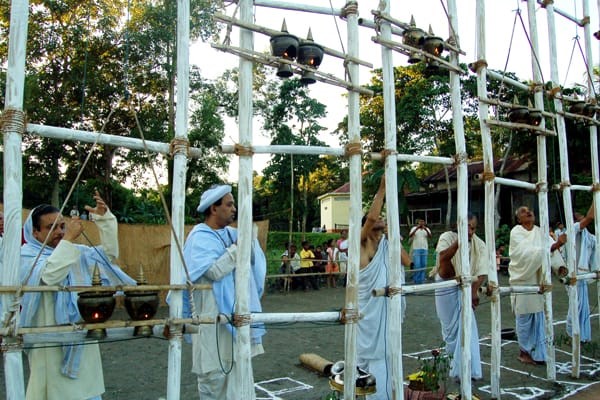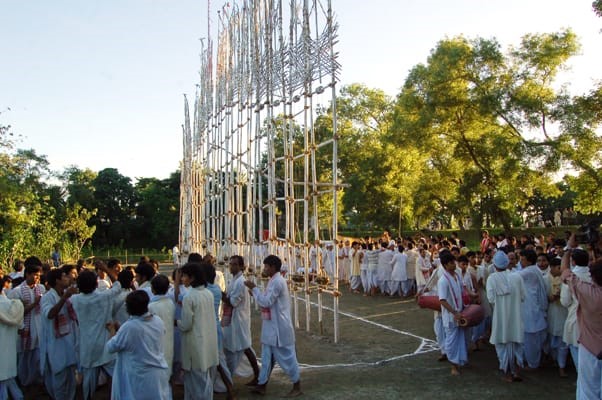Author Archive
Member Book
Learn more about our ICICH members in this book, which profiles many of our members as of October 2020. Please download both parts:

ICOMOS India (NE) and ICICH Hold Webinar, “Bihu : An Agrarian Festival of Assam”
On 20 September, 2020, ICOMOS India (North East Zone) in association with ICICH hosted the webinar on “Bihu: An Agrarian Festival of Assam.” Highlights of the webinar included the following presentations:
- Glorious Intangible Heritages of Bihu festival, Pradip Neog
- Vyah-gowa Ojapali, Dilip Changkaoty
The event was covered in an article published by the Assam Tribune.
Videos
View examples of the intangible heritage related to the festival:
- Bihu dance
- Bihu Husori – example 1
- Bihu Husori – example 2
- Jeng Bihu
- Playing Gogona in Bihu
- Vyah-gowa Ojapali

Celebration of the Kati Bihu festival of Assam at the Auniati Sattrat, Majuli, 17 October 2020. Photographs by Samiran Goswai
Webinar on The Wheel Chart of Sustainability and ICH – 5 November
Thursday 5th November 2020, 14:00-16:00 Helsinki time on ZOOM
Organized by the Finnish Heritage Agency
What does sustainable development mean in practice? How can it be better taken into account while working with living traditions? What can I and my organization do more for a better world?
Learn more about the relation of sustainable development and living heritage. You will also learn how to use the wheel chart in your own work.
The workshop is in English, it is free and open for all. It is intended for anyone working in the field of culture, for NGOs, museums, researchers, educators, government organisations, entrepreneurs…
Learn more and print out your own Wheel Chart from our website.
Register by the 29th Oct the latest to receive the link to participate: https://ssl.eventilla.com/wheelchart
La Finnish Heritage Agency organise un atelier en ligne le 5 novembre 2020 après-midi, sur inscription, autour de la “Wheel Chart of Sustainability and Intangible Cultural Heritage“, support de sensibilisation et de formation aux liens entre patrimoine culturel immatériel & développement durable.
Traduit en français par le ministère de la Culture (DGP – DPRPS), l’outil peut être téléchargé en ligne : https://www.aineetonkulttuuriperinto.fi/en/article/kestavan-kehityksen-kompassi-ja-aineeton-kulttuuriperinto
Symbolic Use of Domestic Space in the Upper Svanetian (Georgia). Vernacular House
Upper Svaneti (Georgia) is a territory in almost permanent isolation amid the Caucasus mountain range. This strategic position, along with the military nature of its settlements made its defence so effective that Svaneti served as Georgia`s safehouse, protecting its chief historical and religious relics in times of crisis. This isolation also ensured the preservation of archaic cultural traditions and ancient rituals, such as animal sacrifices, ritual shaving and blood feuds, establishing what is known as popular religion. Some of these rituals, mainly those performed by women, take place in the domestic space. This paper, developed under the scope of the 3DPast project, aims to interpret the symbolic use of space in vernacular houses of Upper Svaneti. The methodological strategy combines architectonic survey with documental analysis and brings forward an interpretation of this vernacular house from a space anthropology perspective. The traditional svanetian house (machubi), is composed of a single volume, of rough quadrangular plan. The ground floor (machub) houses, during winter, the family and the cattle, while the upper floor (darbazi) was mostly used as the family residence during warmer periods. This analysis will focus specifically on the machub, where there are traces of the symbolic use of domestic space. The machub is composed of a single space with a central fireplace. This element is the axis of segmentation of female and male spaces inside the house. The present paper will address this gender-differentiated symbolic use of the domestic space through the scope of anthropology and of the Svanetian history.
Novas proxémias de valores comunitários
Estes momentos de confinamento obrigatório, aos quais a nossa vida social foi submetida, proporcionaram uma experiência única para se refletir sobre o papel da arquitetura na vida individual e comunitária. A arquitetura é uma das principais profissões responsáveis pela construção dos edifícios nos quais ficamos confinados, bem como pelos diferentes ambientes que definem o espaço construído. Os nossos projetos podem exercer uma clara influência nas relações humanas, pois somos um dos principais agentes dos cenários em que o nosso quotidiano ocorre. Como referido por Durkheim, a arquitetura é um facto social material, ou seja, pode ser a petrificação de um momento cultural. …
Online debate “Food and Cultural Heritage: an EU Policy Perspective”
In the frame of the “Food is Culture” cooperation project co-funded by the EU Creative Europe programme, Europa Nostra – the European Voice of Civil Society committed to cultural heritage – and Slow Food – the international movement to prevent the disappearance of local food cultures and traditions – released an EU policy brief on Food & Cultural Heritage ahead of World Food Day on 16 October.
SAVE THE DATE!
The policy brief on Food & Cultural Heritage will be presented on the occasion of the online debate “Food and Cultural Heritage: an EU Policy Perspective” on Tuesday 17 November from 11:00 to 13:00 CET, taking place in the frame of Slow Food’s Terra Madre Salone del Gusto 2020.
The debate will include a presentation of the art exhibition “What you didn’t know existed. Endangered food from around the world“, which is now available online after having been presented in several cities across Europe. This multimedia artwork aims at raising the public awareness of the richness of our food heritage, which embodies our shared European values, but is also often at risk of disappearing.
REGISTER TO THE ONLINE DEBATE HERE
The Food is Culture project is co-funded by the Creative Europe Programme of the European Union, with the contribution of the Fondazione Cassa di Risparmio di Cuneo. It is led by Slow Food with its partners Europa Nostra, Kinookus, Nova Iskra Creative Hub, and Transpond AB.
The Green Colour of Paradisal Garden and Metaphoric Water: A Divine Gift and Promise from Allah to His People in the Islamic Religion and Environment
Water is the origin of life and the basis on earth. It is deep-rooted as the religion to purify the human soul. In Islam, it makes Muslims feel grateful to Allah as divine generosity. The Court of the Lion in Alhambra elaborates the Koranic verse of “Gardens underneath which rivers flow”. Channels and pools were developed for visual beauty and incorporated into sophisticated building schemes. Water is a complement to the nature in architecture, conveying a sense of repose and freshness. It creates openness and breadth to the enclosed spaces. Moreover, the beautiful nature is Allah’s sign which Muslims contemplate on them. Garden is the space of this meditation and an earthly reflection of Paradise. It is the perfect state of the world. A question arises: what signifies the notion of Paradise? It is a green colour, a linguistic-visual sign. In semiotics, Saussure (1959) divides linguistic signs to the signifier and the signified – a concept or meanings by the signifier. Various meanings are a result of arbitrary relationships between the two factors, caused by perceptions, emotions, and interpretations. This paper focuses on the semiotics of the green colour, to manifest the paradisal garden and metaphoric water in the Islamic religion and environment.
Basic principles and tips for 3D digitisation of cultural heritage published
The Expert Group on Digital Cultural Heritage and Europeana was tasked by the member states of the European Commission to contribute to the development of guidelines on 3D cultural heritage assets. The resulting list of basic principles and tips for 3D digitisation of tangible cultural heritage contains 10 basic principles and a number of tips for each of them geared toward cultural heritage professionals, institutions and regional authorities in charge of Europe’s precious cultural heritage.

